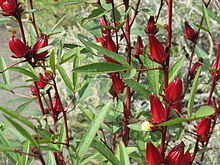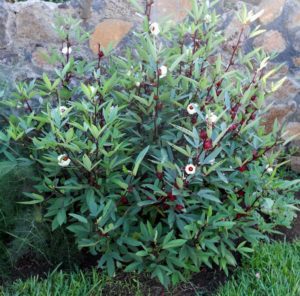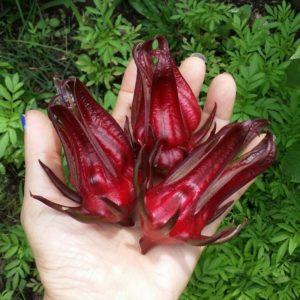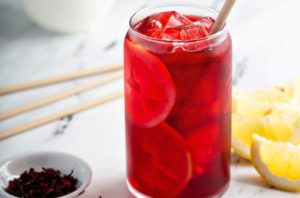Hibiscus, Roselle

Scientific Name: Hibiscus sabdariffa
Introduction: Crimson crowns, both succulent and tart, adorn the glossy stems of this tropical shrub. Hibiscus may be at home in equatorial regions, where it is grown as a shrub, but it can also be grown as an annual in cooler climates by planting the right variety and getting a head start on the season. Brewed as a puckery red tea, hibiscus is enjoyed as a refreshing and medicinal beverage throughout the world. The sour red “fruits” are also enjoyed in jams, chutneys, conserves and alcoholic fermented beverages.
There are several hundred species in the Hibiscus genus, many of which are medicinal or edible, but only Hibiscus sabdariffa produces a fleshy red calyx-roselle is a rare bird in a flock of showy tropical shrubs. In other words, other species of hibiscus cannot substitute for roselle.
Even though hibiscus is a tropical shrub, it can be grown as an annual in temperate climates. To obtain a worthwhile harvest, I recommend getting a head start on the season: plant the seeds in the greenhouse, or under lights, at the same time you start your tomatoes. Transplant the seedlings out in the fields after the danger of frost has passed, taking care not to disturb the finicky roots. Weed assertively when the plants are young, as they become stunted with heavy competition. Once they reach a respectable stature, they can fend for themselves with less coddling on our part.
Roselle’s flowering rhythm is aligned with the cycles of day and night. Specifically, it is a “short-day” plant, which means it begins flowering in the early fall. This timing isn’t so optimal if you live in an area that regularly freezes, as the narrow window between flowering and frost allows for slim pickings if you’re lucky to obtain any harvest at all. The good news is that certain varieties flower earlier, such as ‘Thai red roselle’, which typically begins flowering in July. ‘Thai red roselle’ (the variety pictured here) has a compact form, compared to other members of its species, and bright red, glossy stems. I recommend purchasing the seed from Southern Exposure Seed Exchange. In my experience, other seed sellers do not always have the right variety. For those of you who live outside the tropics, having the right variety makes all the difference between an abundant and a nonexistent harvest.

Roselle produces right up until the first hard freeze and even longer if it is offered protection from light frosts with row covers or blankets. Giving the plants a little protection when the first icy fingers of frost descend upon the land.
In the tropics of the Northern Hemisphere, most day-length-sensitive varieties of roselle flower and fruit from late September through February. If you live in an area that doesn’t freeze, you can grow roselle hibiscus as a short-lived, woody shrub. In tropical zones, the variety of roselle is less important, as there’s no freezing temperatures to dampen the harvest.
Edibility and Preparation: Hibiscus is my kind of herb. It is highly nutritive and easily prepared in a hundred different ways. It’s incredibly safe– it is a traditional food, after all. I readily admit to having dreamed up more recipes with hibiscus than with any other herb and most of my tea blends include Hibiscus since it has so many universal benefits for the body. See below where Hibiscus is featured in the shop!
Both the immature leaves and calyces are edible. The tart young leaves can be eaten raw or cooked, and they are a popular food in many tropical cuisines. The leaves are high in soluble fiber-like okra and oatmeal– and are thus helpful for supporting healthy intestinal flora and reducing excess cholesterol.
The flavor of the juicy calyx is often likened to rhubarb or cranberry. It can be eaten raw or cooked. Its sour flavor, coupled with its natural pectin content, readily lends itself to jams, pies, sauces and chutney. Infused in honey, hibiscus makes a lovely garnet-colored treat with a delectably fruity flavor. Hibiscus is also a common ingredient in garden cocktails. You can use hibiscus honey as a base for hibiscus honey lemonade. The infused honey is also delicious when added to sparkling water.
Nutritionally, hibiscus contains vitamin C and other heart-friendly compounds, such as soluble fiber and anthocyanins. Additionally, hibiscus tea contains calcium, iron, magnesium, and potassium. Boiling the calyces for ten minutes optimally extracts the minerals, flavonoids, and vitamin C.

Medicinal Uses: Hibiscus has been widely adopted in tropical regions around the globe as a refreshing medicinal food and beverage. It is quiet popular in the Caribbean and Central America as a cold herbal tea mixed with sugar; this drink is called sorrel in the islands and agua de flor de Jamaica in Mexico. It is also widely used in Africa and South America as a beverage tea, medicinal herb, and food. In many parts of the world, roselle “fruits” are sold fresh at market. Roselle has been used medicinally in many traditional cultures for its diuretic, hypotensive, and anti-microbial properties. In Mexico, roselle is highly regarded as a natural liver and kidney tonic and weight-loss herb. With its demulcent and soothing qualities, hibiscus is also used acutely to assuage colds, mouth sores, and sore throat. It has demonstrated antibacterial actions against a variety of bacteria in in vitro studies.
HIbiscus is also revered for its beneficial effects on the heart through helping to lower cholesterol levels and high blood pressure. High in antioxidant anthocyanins, hibiscus has been the focus of many recent studies for its anti-inflammatory, cardio-protective, neuroprotective, and hepatoprotective (heart, nervous system, and liver, respectively) qualities. Anthocyanins are a type of flavonoid that lends a blue, purple, and reddish tint to many vegetables, flowers, and fruits. Many in vitro studies have demonstrated the ability of concentrated anthocyanin-rich foods and herbs to protect the liver, improve eye sight, and reduce inflammation and the proliferation of human cancer cells. Anthocyanins are potent antioxidants, helpful as a preventative against free-radical stress in the body, which in turn lessens the risk for cancer, heart disease, and inflammatory conditions in general.
In an overview of animal and human studies conducted with hibiscus tea, it was determined that hibiscus was as effective in lowering blood pressure as the blood pressure medication captopril (an angiotensin-converting enzyme [ACE] inhibitor). These studies also demonstrated favorable effects on lipid profiles, including reduced total cholesterol, low-density lipoprotein cholesterol (LDL-C), triglycerides and increased high-density lipoprotein cholesterol (HDL-C).
With its high levels of vitamin C, minerals, soluable fiber, and antioxidant flavonoids, hibiscus tea is one of the most healthful beverage teas on the planet. And considering its widespread popularity as a food around the globe, it has a high degree of safety and can be consumed daily to maintain health and lower the risk of developing cancer and cardiovascular disease-two of the biggest killers in industrialized nations. Plus, it’s wildly delicious and can be woven into food and drinks with endless creative and colorful flair. Check out this simple way to make Hibiscus Icecubes!

Precautions and Contraindications: Roselle has a high safety profile, as it is widely consumed as a food and daily beverage. However, like acidic citrus, it can aggravate heartburn, and it may be too cooling for folks who run very cold. Hibiscus has been shown to increase the urinary excretion of acetaminophen (Tylenol is a common brand). As a precaution, wait three hours after taking acetaminophen before ingesting hibiscus. Hibiscus reduces the absorption of chloroquine (antimalarial, amebicide, and immunosuppressive pharmaceutical). As a diuretic and hypotensive herb, hibiscus could potentially compound the effects of pharmaceuticals with similar actions; however, no studies have examined this compounding action.
Energetics: Cooling and drying (through its diuretic effects) but slightly mucilagnious and moistening to the throat and intestinal mucosa
Actions: Diuretic, hypotensive, anti-inflammatory, cardiotonic, astringent, cholesterol lowering, antioxidant, antimicrobial and demulcent
Hibiscus is featured in: ‘Heart Be Still Tea’, in ‘Red Heart Tea‘, ‘Joy in a Cup,’ ‘Summertime Refresher‘ or on its own as ‘Hibiscus‘
